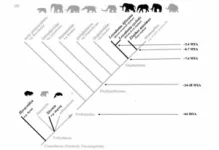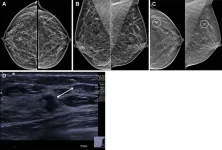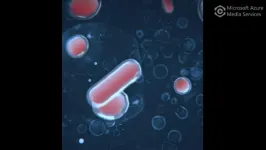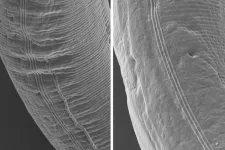(Press-News.org) Humans have complex social behavior, diverse communication skills, and a capacity for highly developed tool use. Researchers argue that human evolution may resemble the process of animal domestication, where less aggressive animals are favoured. In the same way, human evolution may be the result of natural selection for more prosocial and cooperative individuals. Such individuals are more likely to interact with others and form complex communities, in which they can learn from each other.
“The theory of self-domestication is hard to test”, says first author Limor Raviv. “This is because only one other species besides humans has been argued to be self-domesticated: bonobos.” Could elephants be the first non-primate animal model for self-domestication? Raviv and her colleagues set out to study the similarities between elephants, bonobos, and humans, and followed up with a genetic analysis.
Hallmarks of domestication
The team found that elephants show many hallmarks of domestication. Similar to humans and bonobos, they have low levels of aggression, high levels of empathic and prosocial behaviour, an extended juvenile period, and increased playfulness and curiosity. Elephants form coalitions, ‘babysit’ calves, offer protection and comfort to others, and help dying or ill members of their herds—and even the occasional outsider. There is also evidence that elephants are both self-aware and sensitive to the needs and wants of others.
Another important hallmark is elephants’ ability to learn from each other. Behaviours that are often innate in other animals—such as what to eat or how to raise offspring—are socially transmitted in elephants. Elephants also have a sophisticated multimodal communication system with an extensive vocal repertoire, ranging from trumpets and roars to low-frequency rumbles. For example, elephants in Kenya have different alarm calls for humans and for bees. Their varied and combined calls even show signs of grammar.
Finally, the team found several candidate genes associated with domestication in elephants.
Safe environment
The authors propose that self-domestication in elephants could be related to their massive size and relative strength. “This means that elephants are generally less worried about evading or fighting other animals for their survival”, Raviv explains. “This kind of ‘safe environment’ could relax selective pressures for aggression, free cognitive resources, and open up more opportunities for exploration, communication, and play.”
“Our hypothesis of self-domestication in elephants has exciting potential for future research in other species”, concludes Raviv. “It can inform our understanding of the evolution of prosocial behaviour across evolutionarily distant species, providing important insights into convergent evolution.”
END
Elephants as a new model for understanding human evolution
2023-04-04
ELSE PRESS RELEASES FROM THIS DATE:
Deductible, co-pay may lead women to skip breast follow-up
2023-04-04
OAK BROOK, Ill. – Researchers who surveyed women attending breast cancer screening appointments found that one in five is likely to skip additional testing after an abnormal finding on their mammogram if there is a deductible or co-payment, according to an editorial published in Radiology, a journal of the Radiological Society of North America (RSNA).
Health care costs and insurance premiums have increased in recent years. With the advent of the Affordable Care Act (ACA), high-deductible health plans (HDHPs) have grown ...
Ultrasound Effective at Diagnosing Localized Breast Lumps, Pain
2023-04-04
OAK BROOK, Ill. – Ultrasound is an effective standalone diagnostic method in patients with focal breast complaints, according to a study published in Radiology, a journal of the Radiological Society of North America (RSNA). Focal breast complaints can refer to pain, lumps, nipple discharge or other symptoms and conditions confined to a specific area of the breast.
In women, focal breast complaints are a frequent problem. In the Netherlands, approximately 70,000 women visit radiology departments annually with focal breast complaints. The most common being the presence of lumps or pain. Many women who have focal breast complaints are between the ages of 30 and 50 years.
Digital breast ...
ChatGPT helpful for breast cancer screening advice with certain caveats, new study finds
2023-04-04
BALTIMORE, April, 4, 2023-- As more consumers turn to the newly available ChatGPT for health advice, researchers are eager to see whether the information provided by the artificial intelligence chatbot is reliable and accurate. A new study conducted by researchers at the University of Maryland School of Medicine (UMSOM) indicates that the answers generated provide correct information the vast majority of the time; sometimes, though, the information is inaccurate or even fictitious.
Findings were published today in the journal Radiology.
In February 2023, UMSOM researchers created a set of 25 questions related to advice on getting screened ...
Peering into ocular waste recycling
2023-04-04
A recent study in the Journal of Biological Chemistry revealed the key to a protein that commonly causes blindness. The biological process involves a protein that is essential for transporting toxic compounds out of the eye, similar to a garbage recycling service. The challenge is that, like food and the waste it generates, these compounds are essential for the eye to function properly — until they build up and cause blindness.
The scientists behind the study research a protein transporter, called ABCA4, that lines the edges of specialized photoreceptor cells in the retina and is normally poised to remove toxic, fatty retinal byproducts ...
Tired of being alone: How social isolation impacts on our energy
2023-04-04
In a study conducted in the lab as well as during the COVID-19 lockdowns, participants reported higher levels of tiredness after eight hours of social isolation. The results suggest that low energy may be a basic human response to a lack of social contact. The study conducted at the University of Vienna and published in Psychological Science also showed that this response was affected by social personality traits of the participants.
If we do not eat for an extended period, a series of biological processes ensue that create a craving sensation we recognize as hunger. As a social species, we also need other people to survive. Evidence shows that a lack of social contact induces ...
Insilico Medicine presents four posters featuring AI-designed anti-cancer drugs at AACR
2023-04-04
Insilico Medicine (“Insilico”), a clinical-stage generative artificial intelligence (AI)-driven drug discovery company, today announced that four abstracts have been accepted as poster presentations at the American Association for Cancer Research (AACR) Annual Meeting 2023.
Insilico will present four novel inhibitors for the treatment of cancer developed with its end-to-end Pharma.AI platform. Drawing from trillions of data points and millions of compounds and molecular fragments, the platform uses ...
FAU developed AUTOHOLO shows potential as red tide warning system
2023-04-04
Red tides, caused by Karenia brevis blooms, are a recurring problem in the coastal Gulf of Mexico. The organism, Karenia brevis, produces toxins that can cause fish kills, respiratory irritation in humans and cause death in sea turtles, dolphins, manatees and birds.
The ability to detect red tide blooms at all life stages and cell concentrations is critical to increasing predictive capabilities and developing potential mitigation strategies to protect public health and vital resources.
Current methods used to monitor red tide such as microscopic identification and enumeration, standard flow cytometry, as well as others have limitations. Some of these ...
Third major accreditation to help OICR Genomics power next generation of precision medicine
2023-04-04
April 4, 2023, TORONTO — Becoming the first genomics lab to be accredited by three of the leading North American accreditation organizations positions OICR Genomics to generate new discoveries about what drives diseases like cancer and new, personalized ways to diagnose and treat them.
The lab earned a Clinical Laboratory Improvement Amendments (CLIA) certificate of accreditation in January 2023 for its whole genome and whole transcriptome sequencing assay, a comprehensive genetic test that can find all changes in the DNA of a tumour. This comes after accreditation from the College of American Pathologists (CAP) in 2021 and from Accreditation Canada Diagnostics (ACD) — ...
Discovery could hold the key to healthy aging during global warming
2023-04-04
SPOKANE, Wash.—Researchers have long known that many animals live longer in colder climates than in warmer climates. New research in C. elegans nematode worms suggests that this phenomenon is tied to a protein found in the nervous system that controls the expression of collagens, the primary building block of skin, bone and connective tissue in many animals.
Since the C. elegans’ protein is similar to nervous system receptor proteins found in other species including humans, the discovery potentially brings scientists closer to finding ways to harness collagen expression to slow down human aging and increase lifespan in the ...
New shape-shifting antibiotics could fight deadly infections
2023-04-04
In the United States alone, drug-resistant bacteria and fungi infect almost 3 million people per year and kill about 35,000. Antibiotics are essential and effective, but in recent years overuse has led to some bacteria developing resistance to them. The infections are so difficult to treat, the World Health Organization deemed antibiotic resistance a top 10 global public health threat.
Now, Professor John E. Moses at Cold Spring Harbor Laboratory (CSHL) has created a new weapon against these drug-resistant ...






